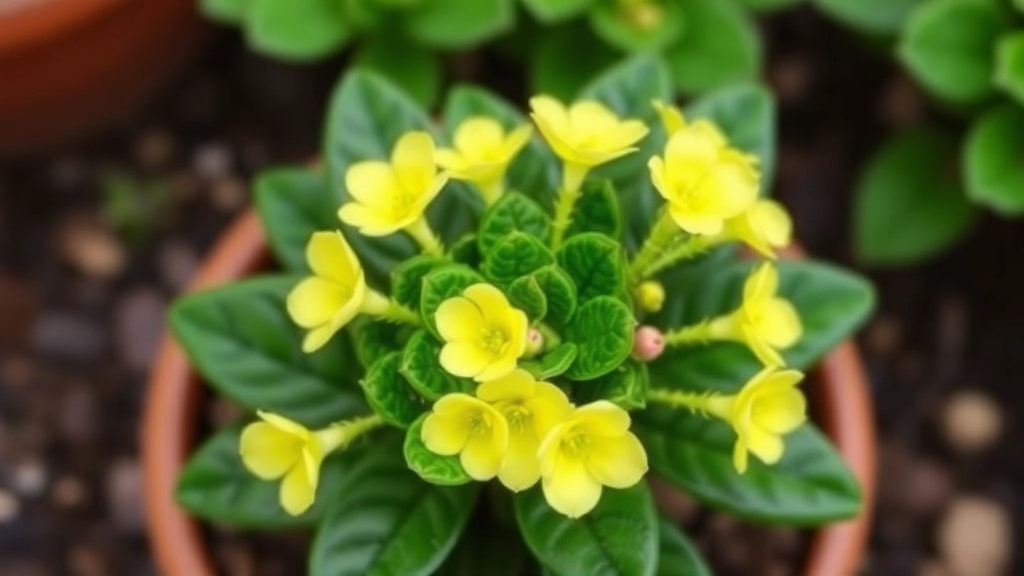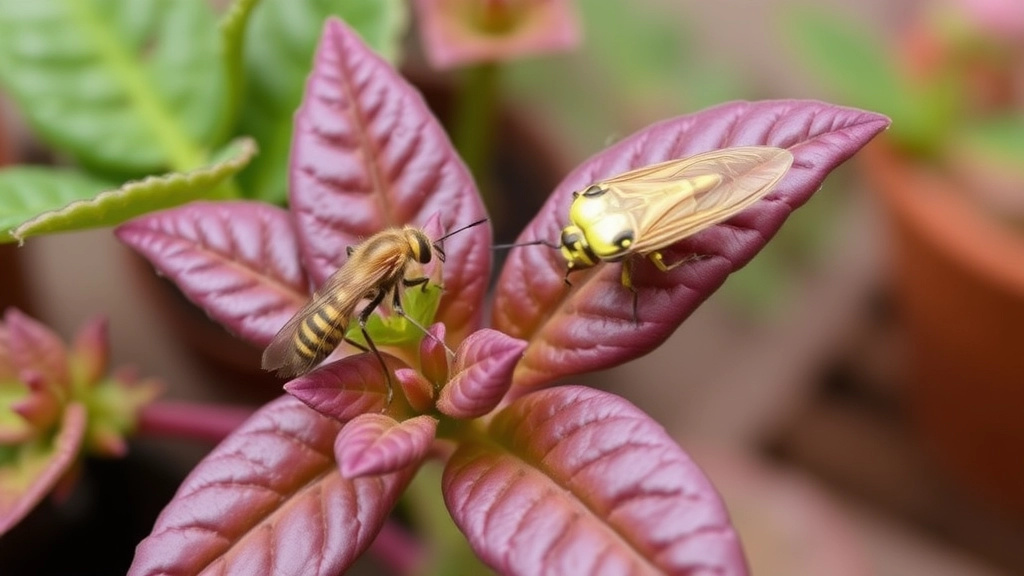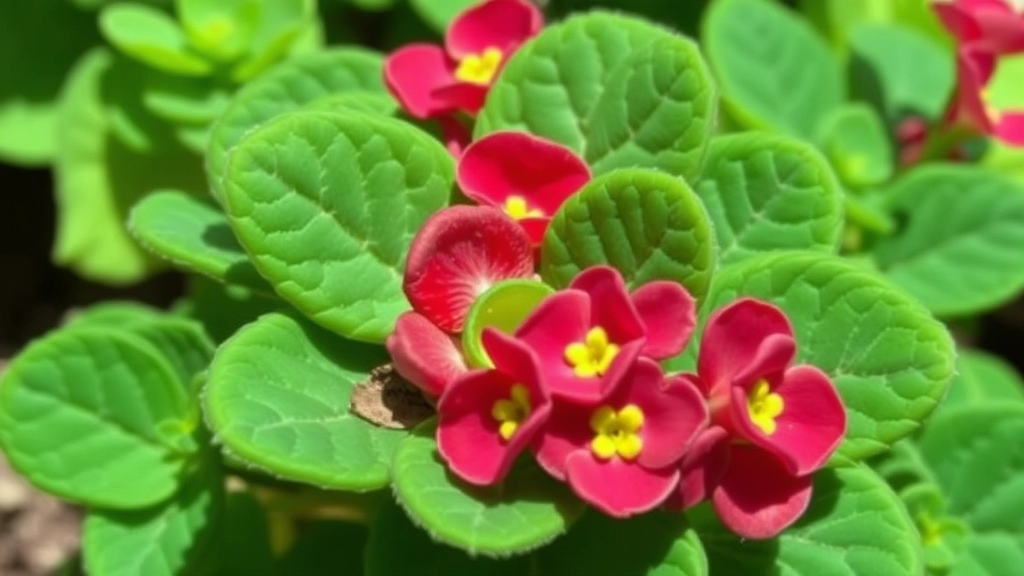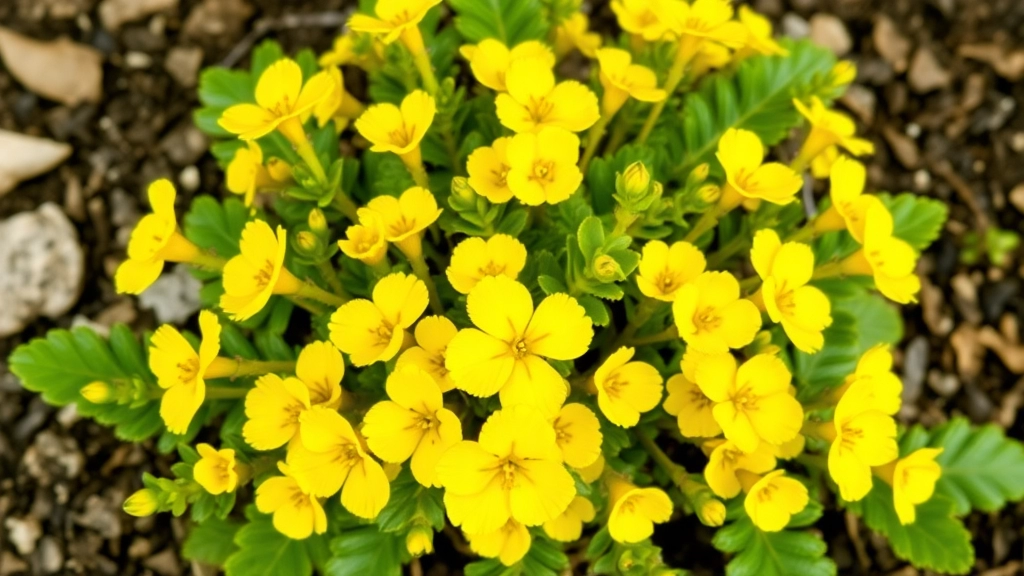Growing Conditions for the Yellow Kalanchoe Plant
When it comes to the Yellow Kalanchoe Plant, getting the growing conditions just right is key. This vibrant flowering succulent thrives in well-draining soil and prefers bright, indirect sunlight. Too much direct light can scorch its leaves, while too little can stunt its growth. Aim for a spot that gets morning sun and afternoon shade for the best results.
Watering Your Yellow Kalanchoe
Watering your Yellow Kalanchoe requires a delicate balance. Overwatering can lead to root rot, while underwatering will leave the plant dry and unhappy. The trick is to let the soil dry out between waterings. During the growing season, consider a balanced liquid fertiliser to keep those yellow blooms vibrant. And remember, proper care can encourage reblooming, adding a continuous splash of colour to your space.
Ideal Growing Conditions for Yellow Kalanchoe
Are you struggling to keep your Yellow Kalanchoe thriving? Understanding the ideal growing conditions is crucial for your plant’s health and vibrancy.
Proper Watering and Fertilization Techniques for Yellow Kalanchoe

So, you’ve got your Yellow Kalanchoe and you’re wondering how to keep it thriving.
Watering Wisely
One of the biggest worries for Kalanchoe owners is overwatering. It’s a common pitfall, and trust me, I’ve been there! Here’s how to nail it:
- Check the Soil: Before you water, stick your finger about an inch into the soil. If it feels dry, it’s time to water.
- Water Deeply: When you do water, give it a good soak until water drains from the bottom of the pot. This ensures the roots are getting enough moisture.
- Frequency: Generally, watering every 2-3 weeks is a good rule of thumb, but this can vary based on the season and your home’s humidity.
Fertilizing Like a Pro
Now, let’s chat about fertilization. It’s essential for keeping your Kalanchoe blooming beautifully.
- Choose the Right Fertilizer: A balanced, water-soluble fertilizer works wonders. Look for something with a ratio like 10-10-10.
- Timing is Everything: Fertilize during the growing season (spring and summer) every 4-6 weeks. In autumn and winter, cut back on fertilization since the plant goes dormant.
- Dilute It: Always dilute the fertilizer to half the recommended strength. This prevents any potential root burn.
Remember, the goal is to support your plant without overwhelming it.
How to Encourage Reblooming in Yellow Kalanchoe
If you’ve ever wondered why your Yellow Kalanchoe isn’t blooming again after its initial display, you’re not alone. Many plant enthusiasts face this challenge, but with the right care, you can encourage your Kalanchoe to produce those vibrant flowers once more.
Understanding the Flowering Cycle
Yellow Kalanchoe typically blooms in the winter and spring, but after this period, it may go dormant. To encourage reblooming, it’s essential to mimic its natural environment. Here are some key strategies:
- Light Management:
- Ensure your plant receives bright, indirect sunlight for at least 6 hours a day.
- If it’s not getting enough light, consider moving it closer to a window or using grow lights.
- Watering Practices:
- Allow the soil to dry out completely between waterings.
- Overwatering can lead to root rot, which inhibits blooming.
- Pruning:
- After the blooming period, trim back spent flowers and any leggy growth.
- This encourages new growth and can stimulate further blooming.
- Fertilization:
- Use a balanced, water-soluble fertilizer every 4-6 weeks during the growing season.
- Look for fertilizers high in phosphorus, which supports flowering.
- Temperature Control:
- Maintain a temperature range between 15°C to 24°C.
- Sudden temperature drops can stress the plant and hinder blooming.
Creating a rest period after the blooming season is crucial. This involves reducing watering and stopping fertilization for about 6 weeks, allowing your plant to gather energy for the next blooming cycle.
For more specific guidance, you might find our expert tips on caring for Kalanchoe succulents helpful. Additionally, understanding the symbolism and cultural significance of Kalanchoe Blossfeldiana can provide deeper insights into this fascinating plant.
Common Pests and How to Protect Your Plant

As we delve into the care of your Yellow Kalanchoe, it’s essential to consider the common pests that can threaten its health.
Identifying Common Pests
Yellow Kalanchoe can be susceptible to various pests, including:
- Mealybugs: These small, white, cotton-like insects often hide in the leaf axils and on stems.
- Spider Mites: Tiny and often found on the undersides of leaves, they can cause stippling and webbing.
- Aphids: These small green or black insects can cluster on new growth, sucking sap and causing distortion.
Signs of Infestation
Keep an eye out for:
- Yellowing leaves
- Sticky residue (honeydew) on leaves or surrounding surfaces
- Webbing or fine silk threads
Protecting Your Yellow Kalanchoe
To safeguard your plant from these pests, consider the following strategies:
- Regular Inspection: Check your plant weekly for any signs of pests.
- Natural Predators: Introduce beneficial insects, such as ladybugs, to help control pest populations.
- Neem Oil Spray: This natural pesticide can effectively deter many pests. Spray it on affected areas, ensuring thorough coverage.
- Isolate Infested Plants: If you notice any pests, isolate the affected plant to prevent the spread.
Preventative Measures
- Maintain Proper Care: Healthy plants are less susceptible to pests. Ensure your Yellow Kalanchoe receives adequate sunlight, water, and nutrition.
- Cleanliness: Keep the surrounding area clean and free of fallen leaves or debris that can attract pests.
When caring for your Yellow Kalanchoe, understanding when and how to repot is crucial for its overall health. Many plant enthusiasts often wonder, “When should I repot my Kalanchoe?” or “What type of soil is best for succulents?” Let’s explore these essential aspects.
### When to Repot Your Yellow Kalanchoe
Repotting is not just about changing the pot; it’s about giving your plant the best chance to thrive.
**Signs It’s Time to Repot:**
– Roots are growing out of the drainage holes.
– The plant is top-heavy and tipping over.
– Soil dries out too quickly, indicating it’s been depleted of nutrients.
– You notice stunted growth or yellowing leaves.
### Choosing the Right Soil
The right soil is key for succulent health. Yellow Kalanchoe thrives in a well-draining mix.
**Soil Requirements:**
– **Cactus Mix:** A pre-made cactus or succulent mix is ideal.
– **DIY Mix:** Combine equal parts potting soil, sand, and perlite for optimal drainage. For more detailed tips, check out the [best soil for Kalanchoe Blossfeldiana care](https://planthq.org/best-soil-for-kalanchoe-blossfeldiana-care-tips/).
– **pH Level:** Aim for a slightly acidic to neutral pH (around 6.0 to 7.0).
### Tips for Successful Repotting
1. **Select the Right Pot:**
– Choose a pot with drainage holes to prevent waterlogging.
– Ensure the new pot is slightly larger than the current one.
2. **Repotting Process:**
– Gently remove the plant from its old pot.
– Shake off excess soil from the roots.
– Place the plant in the new pot and fill with fresh soil, making sure the crown is above the soil line.
3. **Aftercare:**
– Water sparingly for the first week to allow roots to settle.
– Avoid direct sunlight for a few days post-repotting.
For more comprehensive information on caring for your Kalanchoe, you might find this [complete care guide for Kalanchoe Blossfeldiana](https://planthq.org/complete-care-guide-for-kalanchoe-blossfeldiana-succulent/) helpful.
Sunlight Exposure: How Much Light Does a Kalanchoe Need?

Have you ever wondered why your yellow Kalanchoe isn’t blooming as beautifully as it should?
Well, sunlight exposure plays a major role in the health and vibrancy of your plant.
Kalanchoes are succulents, and they thrive in bright, indirect sunlight.
Here’s what you need to know:
- Ideal Light Conditions: Aim for about 6 hours of bright, indirect sunlight daily. A south-facing window is usually perfect.
- Avoid Direct Sunlight: Too much direct sun can scorch those lovely leaves. If you notice brown spots, it might be time to move your plant a bit further from the window.
- Signs of Insufficient Light: If your Kalanchoe starts to stretch or become leggy, it’s a clear sign it’s craving more light.
- Rotate Your Plant: To ensure even growth, rotate your plant every few weeks. This helps all sides get their fair share of sunshine.
- Seasonal Adjustments: In winter, when days are shorter, consider moving your plant closer to the light source.
How to Propagate Yellow Kalanchoe Successfully
Are you looking to expand your collection of Yellow Kalanchoe or share them with friends? Propagation is a fantastic way to do just that. It’s simpler than you might think, and with the right approach, you’ll have new plants in no time.
Methods of Propagation
- Leaf Cuttings
- Select a healthy leaf from the parent plant.
- Allow the cut end to callous over for a day or two.
- Place the leaf in well-draining soil, burying the cut end slightly.
- Water lightly and keep in a warm, bright location.
- Stem Cuttings
- Cut a healthy stem, ideally around 4-6 inches long.
- Remove the lower leaves to expose the nodes.
- Let the cut end dry for a day.
- Plant in soil, ensuring the nodes are buried.
- Water sparingly until roots develop.
- Offsets
- Look for small plants growing at the base of the parent plant.
- Gently separate them from the main plant.
- Replant them in their own pots with suitable soil.
Tips for Successful Propagation
- Soil Choice: Use a well-draining succulent mix to prevent rot. For more details, check out our complete guide to Kalanchoe plant care.
- Humidity: Keep the cuttings in a humid environment (like a plastic bag) for the first week.
- Light: Provide bright, indirect sunlight to encourage growth without burning the cuttings. Learn more about the light requirements for Kalanchoe.
Common Concerns
- Why aren’t my cuttings rooting?
Ensure they are in the right soil and receiving adequate light. Overwatering can also hinder root development. - How long does propagation take?
Typically, roots will develop within a few weeks, but patience is key.
Seasonal Care: Adjusting for Dormant and Active Growth Periods

Have you ever wondered why your Yellow Kalanchoe seems to take a break sometimes?
Just like us, plants have their own rhythm. Understanding the seasonal care for your Yellow Kalanchoe can make a world of difference in keeping it vibrant and healthy.
Active Growth Period: Spring and Summer
During spring and summer, your Kalanchoe is in full swing. Here’s how to make the most of this growth phase:
- Watering: Increase your watering frequency. Check the soil; if it’s dry an inch down, it’s time for a drink.
- Fertilization: Feed it with a balanced succulent fertilizer every 4-6 weeks. This gives your plant the nutrients it craves.
- Sunlight: Ensure it gets plenty of bright, indirect sunlight. A south-facing window is ideal.
Dormant Period: Fall and Winter
When autumn rolls in, your Kalanchoe will start to slow down. Here’s how to adjust your care:
- Watering: Cut back on watering. Let the soil dry out more between waterings to prevent root rot.
- Temperature: Keep it in a warmer spot, ideally between 15-20°C. Avoid cold drafts.
- Fertilization: Stop fertilizing altogether. Your plant doesn’t need extra nutrients during dormancy.
Signs of Seasonal Changes
Keep an eye out for these signs to gauge your plant’s mood:
- Active Growth: New leaves or blooms? That’s a happy Kalanchoe.
- Dormancy: Dropping leaves or slowed growth? It’s just resting.
When considering how to enhance your living space with vibrant plants, the yellow kalanchoe stands out as an appealing choice.
### Decorative Uses for Yellow Kalanchoe
The bright, cheerful blooms of yellow kalanchoe make it an ideal candidate for various decorative applications. Here are some creative ideas:
– **Table Centrepieces:** Place a pot of yellow kalanchoe on your dining table for a splash of colour. It can elevate the atmosphere during meals or gatherings.
– **Window Sills:** Their compact size makes them perfect for window sills, where they can bask in natural light while adding warmth to your home.
– **Office Spaces:** A small kalanchoe on your desk can brighten your workspace, providing a refreshing touch that can uplift your mood during long hours.
Р**Hanging Planters:** Consider using hanging planters to showcase the cascading blooms, adding dimension to your d̩cor.
– **Mixed Arrangements:** Combine yellow kalanchoe with other succulents or flowering plants in a larger arrangement for a stunning visual effect.
### Gifting Ideas Featuring Yellow Kalanchoe
If you’re looking for a thoughtful gift, yellow kalanchoe is an excellent option. Here are some ideas to inspire your gifting:
– **Housewarming Gifts:** A potted yellow kalanchoe is a lovely gesture for new homeowners, symbolising warmth and prosperity.
– **Birthday Surprises:** Brighten someone’s special day with a kalanchoe in full bloom, adding a personal touch to your gift.
– **Celebration of Achievements:** Whether it’s a promotion or graduation, gifting a yellow kalanchoe can convey congratulations in a unique way.
– **Thank You Gifts:** A small kalanchoe can express gratitude beautifully, especially when paired with a handwritten note.
Incorporating yellow kalanchoe into your home or gifting it to others not only enhances aesthetics but also brings joy and positivity. For more detailed care instructions, check out our [Calandiva Yellow Kalanchoe Care Guide](https://planthq.org/calandiva-yellow-kalanchoe-care-guide-tips-for-healthy-growth/). Additionally, if you’re interested in exploring other vibrant varieties, our [Kalanchoe Species Visual Guide](https://planthq.org/kalanchoe-species-photos-visual-guide-and-care-tips/) offers a comprehensive look at different types of kalanchoe plants.
FAQs on Yellow Kalanchoe Plant Care
How often should I water my Yellow Kalanchoe?
Generally, watering every 2-3 weeks is a good rule of thumb. However, always check the soil first; if it feels dry an inch down, it’s time to water. Overwatering is a common issue, so ensure the soil is dry before watering again.
What type of fertilizer is best for Yellow Kalanchoe?
A balanced, water-soluble fertilizer with a ratio like 10-10-10 works wonders. During the growing season (spring and summer), fertilize every 4-6 weeks. Dilute the fertilizer to half the recommended strength to avoid root burn.
How can I identify common pests on my Yellow Kalanchoe?
Watch out for mealybugs, spider mites, and aphids. Signs of infestation include yellowing leaves, sticky residue (honeydew), and webbing or fine silk threads. Regularly inspect your plant for these pests.
How much sunlight does a Yellow Kalanchoe need?
Your Kalanchoe thrives in bright, indirect sunlight. Aim for about 6 hours of bright, indirect sunlight daily. Avoid direct sunlight as it can scorch the leaves. If the plant becomes leggy, it needs more light.
What should I do if my Yellow Kalanchoe is infested with pests?
First, isolate the affected plant to prevent the spread. Use natural pesticides like neem oil spray and introduce beneficial insects such as ladybugs. Regularly inspect your plant and maintain cleanliness to prevent future infestations.
How should I adjust care for my Yellow Kalanchoe during different seasons?
During the active growth period (spring and summer), increase watering frequency and fertilize every 4-6 weeks. In the dormant period (fall and winter), cut back on watering and stop fertilizing. Keep the plant in a warmer spot and avoid cold drafts.
What are the signs that my Yellow Kalanchoe needs more light?
If your Kalanchoe starts to stretch or become leggy, it’s a clear sign it’s craving more light. Rotate your plant every few weeks to ensure even growth and consider moving it closer to a light source during shorter winter days.
How can I prevent pest infestations on my Yellow Kalanchoe?
Maintain proper care by ensuring your plant receives adequate sunlight, water, and nutrition. Keep the surrounding area clean and free of fallen leaves or debris. Regularly inspect your plant and introduce natural predators like ladybugs to control pest populations.
What are the signs that my Yellow Kalanchoe is in its dormant period?
Signs of dormancy include dropping leaves and slowed growth. During this time, reduce watering and stop fertilizing. Your plant is just resting and will resume active growth in the spring.
References
-
The Spruce: Kalanchoe Plant Profile
-
Gardening Know How: Kalanchoe Plant Care
-
The Old Farmer’s Almanac: How to Grow Kalanchoe
